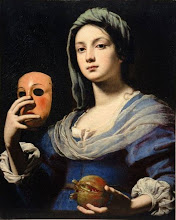
The Non-dual saints and philosophers, have sometimes compared the Self to space/time - to a non-particulate continuum, coextensive with the universe. Shri Jnaneshwara, for example, gave the example of the clay pot - whether the pot is broken or whole, the continuum of space is unchanged; it is illogical to think of the space inside the pot as a separate thing. In the same way, it is mistaken to consider the soul a separate thing to the universal Self.
Our understanding of space/time is limited, and, while this analogy between Self and space/time is a useful way of overcoming the illusion of plural, discrete, separate 'selves', it may also lead some to imagine the Self as a colourless and barren wasteland.
But even time, in a way, has colours. Synchronicity, the principle identified by Carl Jung, gives us a sense that each 'moment' - even though a moment is, in one sense, a false division of something indivisible - has a unique quality, or tint.
In Indian mythology, infinite space/time is embodied as the serpent Ananta (Endless). Perhaps the Self is like the Rainbow Serpent of the Australian Aboriginal Dreamtime: a continuous
thing but multicoloured.
Though it is false to divide the indivisible Self into multiple egos, each human being, through a mysterious principle akin to synchronicity, has a unique quality.
Just as the Rainbow Serpent, in Aboriginal mythology, moved over the featureless landscape of Pre-creation and created geographical features, flora and fauna, the creative aspect of the Self, known in yoga philosophy as Kundalini, the inner serpent-like energy, gives each person their unique tint.
Self-realisation is, in an apparent paradox, the simultaneous dissolving of individuality, and the emergence of uniqueness in a person.
The word
yoga is related to the other Indo-European word
yoke, indicating the sense of
joining or
unifying.
The biggest obstacle to Self-realisation or Yoga (unification of consciousness) is the ego's aversion to an imagined monotone and lifeless void, but Self-realisation is the only means to uniqueness of being.
In Hindu (Vedic) tradition, Shri Shesha is the king of the nagas (serpents)one of the primal beings of creation, and according to the Bhagavata Purana, an avatar of the Supreme God known as Sankarshan. In the Puranas, Shri Shesha is said to hold all the planets of the Universe on his hoods and to constantly sing the glories of Shri Vishnu from all his mouths. He is sometimes referred to as 'Ananta-Shesha' which means 'Endless Shesha'.
Shri Shesha is generally depicted with a massive form that floats coiled in space, or on the universal ocean, to form the bed on which Shri Vishnu lies. Sometimes he is shown as five-headed or seven-headed, but more commonly as a many hundred-headed serpent, sometimes with each head wearing an ornate crown.
He is closely associated with Shri Vishnu. Shesha means 'that which remains', from the Sanskrit root shiş, because when the world is destroyed at the end of the kalpa, Shesha remains as he is.
Balarama (brother of Shri Krishna) and Lakshmana (brother of Shri Rama) are considered avataras (incarnations) of Shri Shesha. Patañjali, the author of the Yoga Sutras, the textual basis of Yoga philosophy, is also considered an emanation or incarnation of Shri Shesha, and is iconographically depicted in naga form with naga canopy.
- Wikipedia






















